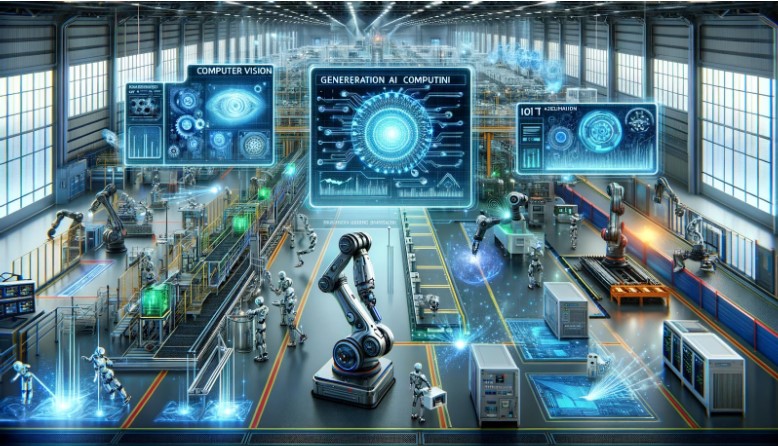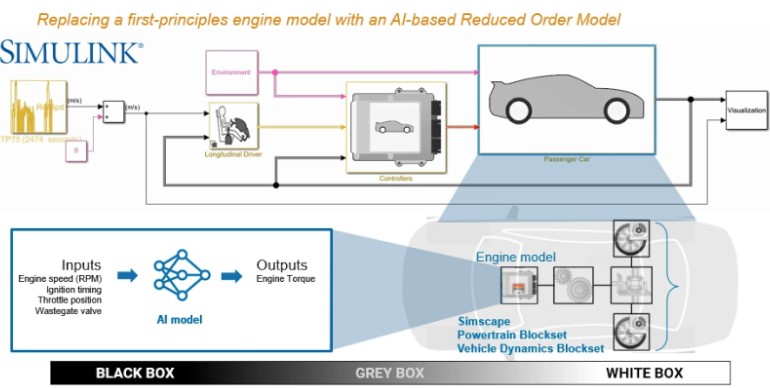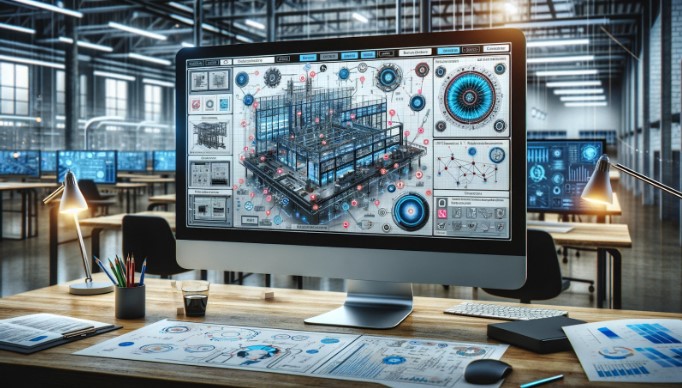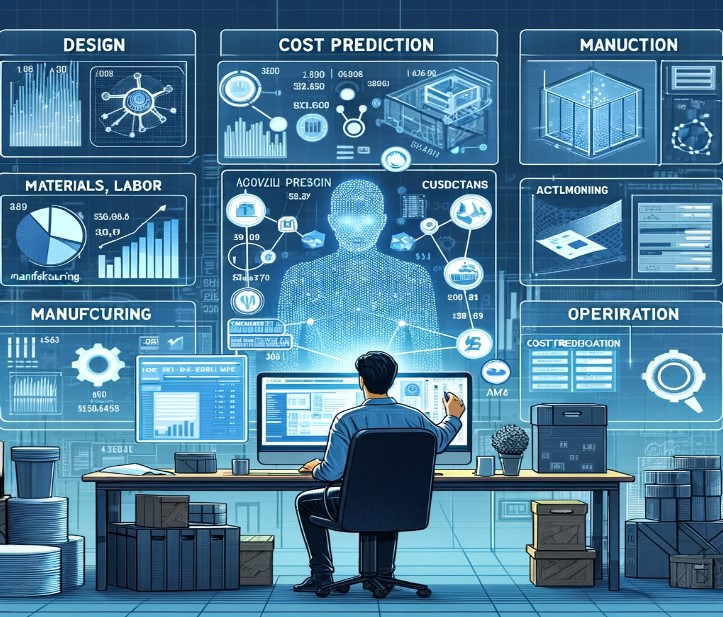Introduction
The advent of Artificial Intelligence (AI) has initiated a paradigm shift across multiple industries, marking an era of unprecedented innovation and efficiency. Its impact is profound in the manufacturing industry, where AI revolutionises processes through advanced robotics, quality control, supply chain optimisation, and predictive maintenance. This transformative power of AI not only increases efficiency and productivity but also enables more complex and intricate manufacturing designs, demonstrating the extensive capabilities of AI in modern industrial applications. AI has become a pivotal tool in these realms, reshaping how designers and engineers approach problems and develop solutions. Key technologies such as Computer Vision (CV), Generative AI, GPU acceleration, and Internet of Things (IoT) edge computing fuel this transformation.
Use Cases of AI in Electrical and Mechanical Design
As these technologies continue to advance, their synergistic impact on electrical and mechanical design is poised to drive further innovation, efficiency, and effectiveness in these critical sectors. Let’s delve into some of these cutting-edge use cases:
a) Explainable Design
Explainable design leverages CV to recognise elements within a structure and their interconnections. This process involves the analysis of design components, understanding their relationships, and interpreting how they function within the more extensive systems. The integration of generative AI further enhances this process by illustrating and modelling these connections, leading to a deeper understanding of the design’s functionality and potential improvements. This approach is particularly beneficial in complex systems such as aerospace and automotive industries, where understanding the intricate relationships between components is crucial.

b) AI-based Reduced Order Models (ROM)
AI-based Reduced Order Models (ROM) involve creating virtual components to simulate real-world behaviour. These models are simplified versions of complex systems designed to predict the behaviour of these systems under various conditions. Using AI in ROM allows for faster computations and more accurate predictions, significantly reducing the time and cost of traditional modelling methods. This technology is invaluable in fields such as material science and fluid dynamics, where predicting material behaviour under different conditions is essential.

c) Simulation optimisation with GPUs
Simulation optimisation with GPUs plays a transformative role in electrical and mechanical design. Leveraging the parallel processing capabilities of GPUs and their custom algorithms accelerates the simulation of complex design scenarios. This optimisation is particularly valuable in areas like the analysis of electrical circuit behaviours, thermo-dynamics in mechanical systems, and stress testing of materials. GPUs enable running more detailed and sophisticated models faster than traditional CPUs, facilitating advanced simulations critical for innovative electrical and mechanical design solutions.
d) Design Evaluation
The AI-driven electrical and mechanical design approach transforms design evaluation through fault detection and risk analysis. Our AI algorithms identify potential errors and weaknesses in complex designs, enable preemptive corrections, and significantly reduce the risk of costly mistakes. Edge computing further enhances these capabilities, allowing real-time data processing and swift decision-making in collaborative environments. This is particularly crucial in industries like manufacturing and construction, where timely identification of faults and risks can lead to substantial cost savings and improved safety. Our AI services thus play a vital role in optimising the design process and ensuring the final product’s durability and reliability.

e) Cost Prediction of a Design
Cost prediction in design involves estimating the financial implications of a design before it is executed. This process includes calculating material, labour, manufacturing, and potential operational costs. AI algorithms can analyse past projects and market data for more accurate cost estimations. This predictive capability is crucial for budgeting and financial planning, especially in large-scale construction, manufacturing, and product development projects.

Benefits of AI in Electrical and Mechanical Design
Integrating AI and automation technologies in business practises is not just about automating tasks; it’s about enhancing human capabilities and making processes more efficient and effective. As these technologies evolve, their impact on design and engineering will only grow, leading to more innovative, cost-effective and safer solutions in various industries. Here are the details, backed by studies and reports:
Enhancing Efficiency in Electrical and Mechanical Design:
In the specific realms of electrical and mechanical design, advanced technologies like generative AI are making a significant impact on reducing costs and time constraints. By automating complex design processes and enabling rapid prototyping, generative AI is transforming the efficiency with which these industries operate. For instance, in electrical design, AI-driven tools can optimise circuit layouts and energy consumption. They can enhance the precision and efficiency of creating intricate machine parts in mechanical design. This evolution in design methodology streamlines the development process and leads to more innovative and effective solutions. Active collaboration between industry and technology experts is crucial to fully leveraging these advancements and managing the transition towards more AI-integrated electrical and mechanical design workflows.
Standardisation of Design Documentation Across the Company:
The standardisation of design documentation is pivotal in enhancing efficiency and accuracy. For example, AI-driven 3-D modelling and simulation tools revolutionise the design of electrical and mechanical components. These tools enable engineers to create detailed virtual prototypes, streamlining the development process and ensuring consistency across all design stages. In electrical design, AI facilitates the creation of comprehensive wiring diagrams and circuit models, bearing in mind short iterations and changes. This results in more efficient design processes, reducing the time and cost of guide drafting and error correction. Similarly, in mechanical design, AI-powered equipment helps model mechanical components and systems precisely, ensuring that designs meet specific requirements and regulations. This no longer simply speeds up the time to market but also allows for an immediate model for new design challenges and technological advancements. By integrating AI into the design process, companies can achieve a higher level of standardisation in their documentation, leading to improved product excellence and a more efficient workflow.
Risk Management:
AI plays a transformative role in enhancing the accuracy of risk assessment in mechanical and electrical systems and streamlines the decision-making process. By using AI to process and analyse vast amounts of data, designers can identify and mitigate risks early in the development phase, reducing the likelihood of costly revisions and downtime. Integrating AI in mechanical and electrical design is thus a significant stride towards advancing these industries, ensuring they remain resilient and adaptive in an ever-changing technological landscape. These studies provide concrete evidence of the significant advantages of AI and related technologies regarding efficiency, cost reduction, and risk management. They indicate a trend towards greater reliance on these technologies across various business functions, underscoring their growing importance in the modern business landscape.
Challenges of using AI in this field
While having numerous benefits, the integration of AI technology in diverse businesses faces several challenges:
Mechanical Design Challenges:
Sustainability and Efficiency: One of the primary hurdles is the difficulty in aligning AI capabilities with the demands of modern mechanical engineering, which prioritises sustainability and efficiency. Despite its advanced computational power, AI sometimes struggles to perfectly balance innovative product design with environmental friendliness, price effectiveness, and waste reduction. The complexity arises from the need for AI systems to understand and observe intricate sustainability criteria while preserving innovation and efficiency. This presents a nuanced challenge: ensuring AI can create designs that are no longer best technically advanced but also environmentally sustainable and economically viable.
Multi-Objective Optimisation: The design process in mechanical engineering involves multi-objective optimisation, considering various factors like material, cost, and manufacturing methods. This complexity adds to the challenge of applying AI effectively in mechanical design.
Electrical Design Challenges:
Data Privacy and Cybersecurity: In electrical engineering, AI relies heavily on facts, necessitating stringent measures to protect sensitive data, which includes energy consumption patterns, from unauthorised access or cyberattacks.
Complexity of Systems: Electrical systems often comprise multiple interconnected components with unique characteristics. This complexity challenges the development of AI algorithms that accurately model and predict system behaviour.
Lack of Standardisation: Standards are needed for integrating AI into electrical engineering, avoiding inconsistencies in the AI model learning. This loss of standardisation hampers the ability to compare results and assess the effectiveness of different AI solutions.
General Challenges in Both Fields:
Insufficient Data: AI algorithms require large amounts of remarkable statistics. In many cases, these records need to be in a layout that AI systems can efficiently process, hindering the effective implementation of AI in electrical and mechanical engineering.
Integrating AI in electrical and mechanical design is a dynamic and evolving field with potential benefits. However, these challenges must be addressed to harness AI’s capabilities entirely in these areas. Developing solutions for these issues involves technological advancements and coverage considerations, mainly in privacy and standardisation areas.
TechnoLynx, as a software research and development consulting business corporation, addresses the challenges of integrating AI into electrical and mechanical design by offering custom, innovative solutions tailored to your specific needs:
- Data Management and Security Solutions: Recognising the essential need for information privacy and cybersecurity in AI applications, we offer sturdy statistics management solutions. These ensure the secure management and protection of sensitive information, which is necessary for electrical engineering projects.
- Complex Systems Modelling: Our expertise in AI enables us to develop sophisticated algorithms capable of handling the complexity and interconnected nature of electrical and mechanical systems. We offer solutions that accurately model and predict system behaviour, enhancing design efficiency and reliability.
- Custom AI Algorithm Development: Understanding the inadequacy of standardisation in AI applications, we specialise in developing custom AI algorithms. These are tailored to meet the unique requirements of your projects, ensuring optimal performance and efficiency.
- Training and Support: We also offer comprehensive training and support services to ensure your team can effectively leverage AI technologies.
By partnering with us, you gain access to cutting-edge AI technologies and customised solutions that address the specific challenges in your field, driving innovation and enhancing competitiveness.
In conclusion, integrating AI into electrical and mechanical design heralds a new era of innovation and efficiency. AI facilitates various advanced applications, from explainable design to AI-based reduced order models, optimising simulation processes, enhancing cost prediction accuracy, and refining design evaluations. These benefits collectively revolutionise the engineering landscape, streamlining workflows and driving effectiveness. While challenges such as ensuring data quality, managing integration complexity, and enhancing interpretability remain, they are surmountable with tailored solutions and specialised expertise. The future of AI in these fields is promising, and it is poised to evolve and redefine electrical and mechanical engineering paradigms continually.
References:
Dhakal, G. (2023). Artificial Intelligence in Electrical Engineering: Applications, Challenges, and Future.
Frackiewicz, M. (2023). Integrating AI in Electrical Engineering: Challenges and Opportunities.
Massobrio, A. (2020). How is AI used in Mechanical Engineering?












